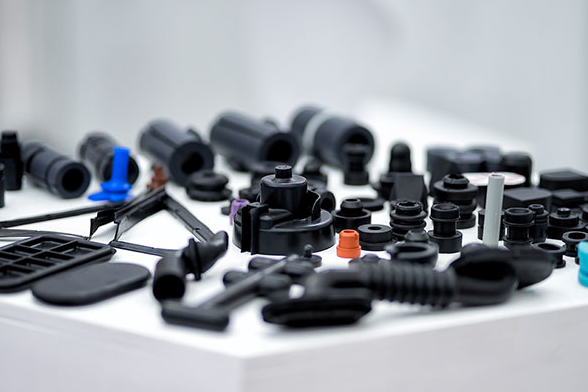Automotive plastic injection molding is a process for creating durable, precision parts used in vehicle manufacturing, like dashboards and bumpers.
Basics of Automotive Plastic Injection Molding
Automotive plastic injection molding is a pivotal process in the manufacturing of a vast array of vehicle components. This method combines efficiency, precision, and versatility, making it a cornerstone in automotive production.

Defining Plastic Injection Molding in Automotive Applications
Process: Melting thermoplastic polymers and injecting them into a mold.
Components: Produces a variety of parts, including dashboards, bumpers, and light casings.
Advantages: High precision in dimensions and consistency in production.
Efficiency: It offers fast production cycles – typically seconds per part.
Cost-Effectiveness: Reduces labor costs and minimizes waste material.
History and Evolution in the Automotive Industry
Early Use: Began in the 1970s, initially for small, non-critical parts.
Advancements: The 1990s saw the integration of advanced polymers, allowing for more complex and durable components.
Modern Developments: Continuous improvements in machine efficiency and energy consumption. Current machines use about 15-30 kW of power, significantly less than earlier models.
Future Trends: Focus on sustainable materials and reduced carbon footprint in production.
Significant Milestones:
Material Evolution: Introduction of high-performance plastics with improved heat resistance and durability.
Technological Innovations: Development of precision molding techniques and computer-aided design (CAD) integration.
For a comprehensive understanding of automotive plastic injection molding, visit Injection Molding on Wikipedia.
Materials Used in Automotive Injection Molding
The choice of materials in automotive injection molding significantly influences the performance, durability, and cost-effectiveness of produced components. Understanding the properties and selection criteria of common polymers is crucial for optimal part design and functionality.
Overview of Common Polymers and Their Properties
Acrylonitrile Butadiene Styrene (ABS):
Strength: High impact resistance and toughness.
Cost: Approximately $1.50 – $2.50 per pound.
Usage: Ideal for interior trims, dashboards, and consoles.
Polycarbonate (PC):
Strength: Notable for its durability and heat resistance.
Cost: Ranges from $2.75 – $3.50 per pound.
Usage: Used in headlamp lenses, bumpers, and exterior panels.
Polypropylene (PP):
Strength: Offers flexibility and chemical resistance.
Cost: Typically $1.00 – $2.00 per pound.
Usage: Common in bumpers, cladding, and containers.
Polyethylene (PE):
Strength: Known for its low weight and high durability.
Cost: About $0.90 – $1.50 per pound.
Usage: Used in fuel tanks and various under-hood components.
Polyamide (Nylon):
Strength: Excellent heat resistance and mechanical strength.
Cost: Generally $2.00 – $3.00 per pound.
Usage: Suitable for engine covers, air ducts, and radiator end tanks.
Material Selection Criteria for Automotive Components
Key factors in material selection include:
Mechanical Properties: Tensile strength, flexibility, and impact resistance.
Thermal Performance: Ability to withstand high temperatures.
Chemical Resistance: Durability against oils, coolants, and other chemicals.
Cost Efficiency: Balancing performance with material costs.
Sustainability: Preference for recyclable and eco-friendly materials.
For more detailed information, explore Automotive Materials on Wikipedia.
Design Considerations in Automotive Injection Molding
The design of automotive plastic parts through injection molding is a complex process that requires careful consideration of various factors. These considerations ensure the parts meet both aesthetic and functional standards while being cost-effective.
Key Factors in Designing Automotive Plastic Parts
| Factor | Description | Impact |
|---|---|---|
| Material Selection | Choosing the right polymer based on part requirements. | Determines strength, durability, and cost. |
| Part Geometry | Designing the shape and dimensions of the part. | Affects mold complexity and production ease. |
| Tolerance Levels | Precision levels required for the part’s dimensions. | Ensures fit and function within assemblies. |
| Surface Finish | The texture and appearance of the part’s surface. | Impacts aesthetics and tactile feel. |
| Gate Location | Deciding where in the mold the plastic enters. | Influences material flow and part quality. |
Integration with Vehicle Design and Functionality
| Aspect | Description | Impact |
|---|---|---|
| Aesthetic Alignment | Ensuring the part aligns with the vehicle’s overall design language. | Contributes to the visual appeal. |
| Functional Integration | How the part interacts with other vehicle components. | Affects overall vehicle performance. |
| Thermal Management | Considering how the part behaves under different temperatures. | Ensures durability in varied conditions. |
| Safety Compliance | Adhering to industry safety standards. | Essential for user safety and legality. |
| Manufacturing Feasibility | Ensuring the design is practical for production. | Impacts cost-efficiency and scalability. |
For a deeper understanding of these considerations, explore Automotive Design on Wikipedia.
Quality Control and Testing in Automotive Injection Molding
Ensuring the highest standards of quality and safety is paramount in automotive injection molding. The process involves stringent quality assurance practices and robust testing methods to guarantee the durability and safety of automotive components.

Standard Quality Assurance Practices
Quality assurance in automotive injection molding includes:
Inspection Protocols: Regular checks during production for consistency in dimensions and appearance.
Material Quality Control: Verifying the quality of polymers used to ensure they meet specified standards.
Process Monitoring: Continuous monitoring of injection molding parameters like temperature, pressure, and cycle time.
Employee Training: Skilled technicians and operators trained to identify and rectify quality issues.
Documentation: Maintaining detailed records of production, inspections, and corrective actions.
Testing Methods for Durability and Safety
Testing automotive components for durability and safety involves:
Impact Testing: Assessing the resistance of parts to impacts, crucial for components like bumpers.
Thermal Testing: Evaluating how parts withstand extreme temperatures, ensuring functionality under different conditions.
Chemical Resistance Testing: Checking the durability of parts against chemicals like oils and coolants.
Fatigue Testing: Measuring how parts endure repeated stress, vital for components that experience regular use.
Safety Compliance Tests: Ensuring parts meet automotive safety standards, a critical aspect for all vehicle components.
Efficiency and Cost Implications:
Testing Speed: Fast and accurate testing methods save time, enhancing overall production efficiency.
Cost Management: Effective quality control reduces the need for rework, lowering overall manufacturing costs.
For more insights on these practices, visit Automotive Safety Testing on Wikipedia.




